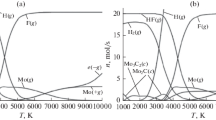Abstract
A procedure for simulating gas-dynamic and thermal conditions during the conversion in a radiofrequency induction (RFI) plasma reactor has been developed. The model includes a turbulent flow of a mixture of ideal viscous compressible gases, taking into account inductive heating of the gas through heat conduction, convection, and radiation, considering the effect of the electromagnetic field force on the plasma motion. The formation of powder particles agrees with the results of thermodynamic calculations; the distribution of particles in the flow is described by the diffusion mechanism. The results of the simulation of the conversion of volatile boron chloride and boron fluoride in an RFI plasma torch with vortex-stabilized flow are presented.





Similar content being viewed by others
REFERENCES
Grishin, Yu.M. and Myao, L., Nauka Obraz. MGTU im. N.E. Baumana, Elektron. Zh., 2016, no. 5, p. 104.
Cao, T. and Cheng, Y., Plasma Sources Sci. Technol., 2016, vol. 25, no. 2, p. 025011.
Ivanov, D.V. and Zverev, S.G., IEEE Trans. Plasma Sci., 2017, vol. 45, no. 12, p. 3125.
Reinisch, G., Leyssale, J.-M., Bertrand, N., Chollon, G., Langlais, F., and Vignoles, G., Surf. Coat. Technol., 2008, vol. 203, p. 643.
Shabarova, L.V., Kornev, R.A., and Sennikov, P.G., High Energy Chem., 2018, vol. 52, no. 5, p. 423.
Kut’in, A.M., Thermodynamic models of multicomponent heterophase systems and production of materials from organoelement compounds, Doctoral (Chemistry) Dissertation, Nizhny Novgorod, 2001.
Iorish, V.S., Belov, G.V., and Yungman, V.S., Software suite IVTAN TERMO for Windows and its use in applied thermodynamic analysis, Preprint of Joint Institute for High Temperatures, Russ. Acad. Sci., Moscow, 1998, no. 8.
Entsiklopediya nizkotemperaturnoi plazmy, kn. 1: Nizkotemperaturnaya plazma. Osnovnye ponyatiya, svoistva i zakonomernosti (Encyclopedia of Low-Temperature Plasma, book 1: Low-Temperature Plasma: Basic Concepts, Laws, and Properties), Fortov, V.E., ed.-in-chief, Moscow: Nauka, 2000.
Anderson, D.A., Tannehill, J.C., and Pletcher, R.H., Computational Fluid Dynamics and Heat Transfer, New York: Hemisphere, 1984.
Vorob'ev, A.Kh., Diffuzionnye zadachi v khimicheskoi kinetike (Diffusion Problems in Chemical Kinetics), Moscow: Izd. Moskovskogo Universiteta, 2003.
Murphy, A.B., Plasma Chem. Plasma Process., 2000, vol. 20, no. 3, p. 279.
Gamburg, D.Yu. Semenov, V.P., and Dubovkin, N.F., Vodorod. Svoistva, poluchenie, khranenie, transportirovanie, primenenie (Hydrogen: Properties, Production, Storage, Transportation, and Use), Moscow: Khimiya, 1989.
Bretsznajder, S., Wlasnosci gazow i cieczy (The Properties of Gases and Liquids), Warsaw: Wydawnictwo Naukowo-Techniczne, 1962.
ACKNOWLEDGMENTS
This work was supported by the Russian Science Foundation, project no. 17-13-01027.
Author information
Authors and Affiliations
Corresponding author
Additional information
Translated by V. Avdeeva
Rights and permissions
About this article
Cite this article
Shabarova, L.V., Plekhovich, A.D., Kut’in, A.M. et al. Comparative Study of Gas-Dynamic Processes in Inductively Coupled Argon–Hydrogen Plasma Containing Boron Trichloride and Boron Trifluoride. High Energy Chem 53, 155–161 (2019). https://doi.org/10.1134/S0018143919020140
Received:
Revised:
Accepted:
Published:
Issue Date:
DOI: https://doi.org/10.1134/S0018143919020140




